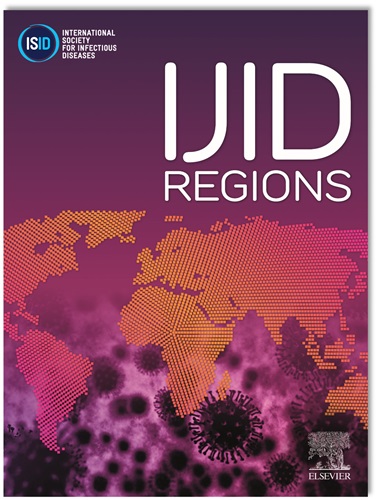Assessing the prognostic accuracy of the PSS, pSOFA, and SIRS for in-hospital mortality in children with suspected infection in non-ICU settings: a multicenter retrospective study
IF 4.3
2区 医学
Q1 INFECTIOUS DISEASES
引用次数: 0
Abstract
Objectives
To systematically compare the predictive accuracy of the Phoenix Sepsis Score (PSS), the Pediatric Sequential Organ Failure Assessment (pSOFA), and systemic inflammatory response syndrome (SIRS) in assessing in-hospital mortality risk among pediatric sepsis patients in non-intensive care unit (non-ICU) wards, thereby providing evidence-based support for clinical risk stratification.
Design
This study employed a multicenter retrospective cohort design, enrolling non-ICU pediatric patients with suspected infections (excluding preterm infants and neonates hospitalized immediately after birth), to construct an overall cohort and a neonatology subgroup cohort. Clinical parameters were collected through a data acquisition system, with parallel calculations of PSS, pSOFA, and SIRS scores. The primary endpoint was in-hospital mortality. Receiver operating characteristic (ROC) curves were constructed via R language version 4.3.1, and the discriminatory performance of each scoring system was evaluated via the area under the ROC curve (AUROC).
Results
From January 2023 to September 2024, 965 non-ICU pediatric patients with infections were enrolled from 13 medical centers (overall cohort mortality: 1.1%, 11/965; neonatology cohort: 193 cases, mortality: 4.1%, 8/193). In the overall cohort, all 11 patients experienced deterioration on the ward and were subsequently transferred to the pediatric intensive care unit (PICU) in accordance with each hospital's protocol; eight of them died from sepsis, and three from septic shock. After multivariate adjustment, the AUROC value of the PSS score in the overall cohort was 0.756 (99% CI: 0.731-0.780), representing a 3.6% improvement over the SIRS criteria (0.730, 99% CI: 0.543-0.873) but lower than the pSOFA score (0.845, 99% CI: 0.568-0.966). In the neonatology cohort, the AUROC value of the PSS score was 0.764 (99% CI: 0.478-0.927), comparable to that of the SIRS criteria (0.757, 99% CI: 0.475-0.905) but still lower than that of the pSOFA score (0.819, 99% CI: 0.533-0.983). No statistically significant differences were observed among the three scoring systems (P > 0.01).
Conclusions
These findings suggest that the PSS score does not demonstrate superior predictive value compared with traditional assessment tools in non-ICU clinical scenarios.
评估PSS、pSOFA和SIRS对非icu环境中疑似感染儿童住院死亡率的预测准确性:一项多中心回顾性研究
目的:系统比较Phoenix脓毒症评分(PSS)、小儿顺序器官衰竭评估(pSOFA)和全身性炎症反应综合征(SIRS)在评估非icu病房儿科脓毒症患者住院死亡风险中的预测准确性,为临床风险分层提供循证支持。设计:本研究采用多中心回顾性队列设计,纳入疑似感染的非icu儿科患者(不包括早产儿和出生后立即住院的新生儿),构建总队列和新生儿亚组队列。通过数据采集系统收集临床参数,并并行计算PSS、pSOFA和SIRS评分。主要终点是住院死亡率。采用R语言4.3.1版构建受试者工作特征(ROC)曲线,通过ROC曲线下面积(AUROC)评价各评分系统的区分效果。结果:2023年1月至2024年9月,共纳入13个医疗中心的965例非icu感染患儿(总队列死亡率:1.1%,11/965;新生儿亚组:193例,死亡率:4.1%,8/193)。在整个队列中,所有11名患者在病房出现病情恶化,随后根据每家医院的方案转至PICU;其中8人死于败血症,3人死于感染性休克。多因素调整后,整个队列中PSS评分的AUROC值为0.756 (99% CI: 0.731-0.780),比SIRS标准(0.730,99% CI: 0.543-0.873)提高了3.6%,但低于pSOFA评分(0.845,99% CI: 0.568-0.966)。在新生儿亚组中,PSS评分的AUROC值为0.764 (99% CI: 0.478 ~ 0.927),与SIRS标准(0.757,99% CI: 0.475 ~ 0.905)相当,但仍低于pSOFA评分(0.819,99% CI: 0.533 ~ 0.983)。三种评分系统间比较差异无统计学意义(P < 0.05)。结论:这些研究结果表明,在非icu临床情况下,与传统评估工具相比,PSS评分并没有表现出优越的预测价值。
本文章由计算机程序翻译,如有差异,请以英文原文为准。
求助全文
约1分钟内获得全文
求助全文
来源期刊
CiteScore
18.90
自引率
2.40%
发文量
1020
审稿时长
30 days
期刊介绍:
International Journal of Infectious Diseases (IJID)
Publisher: International Society for Infectious Diseases
Publication Frequency: Monthly
Type: Peer-reviewed, Open Access
Scope:
Publishes original clinical and laboratory-based research.
Reports clinical trials, reviews, and some case reports.
Focuses on epidemiology, clinical diagnosis, treatment, and control of infectious diseases.
Emphasizes diseases common in under-resourced countries.

 求助内容:
求助内容: 应助结果提醒方式:
应助结果提醒方式:


